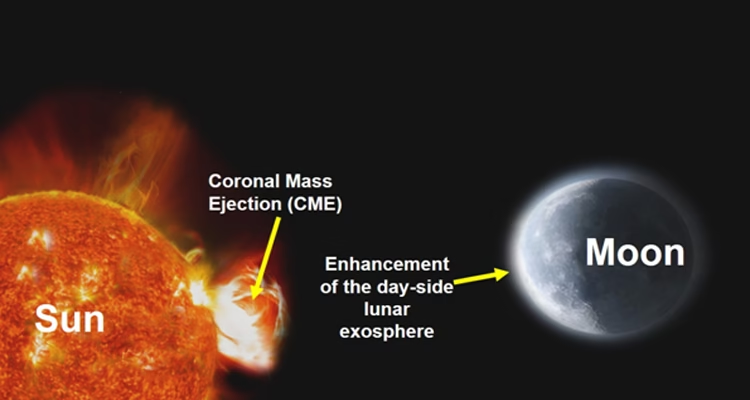Bengaluru: In a groundbreaking discovery, India’s Chandrayaan-2 mission has made the world’s first direct observation of how the Sun’s massive solar eruptions — known as Coronal Mass Ejections (CMEs) — affect the Moon’s fragile atmosphere.
The Indian Space Research Organisation (ISRO) announced that its lunar orbiter, launched in July 2019, captured the rare phenomenon through its onboard instrument CHACE-2 (Chandra’s Atmospheric Compositional Explorer-2).
India’s Chandrayaan-2 observes effects of the Coronal Mass Ejections from the Sun on the Moon. First-ever observations showed an increase in the total pressure of the dayside environment of the Moon.
For details, please visithttps://t.co/Yvc7xcxR00
— ISRO (@isro) October 18, 2025
Chandrayaan-2’s Breakthrough Discovery
The finding marks a major leap in understanding how solar activity influences the lunar exosphere — the Moon’s paper-thin atmosphere — and could help shape the design of future lunar missions and human habitats.
During a powerful solar storm on May 10, 2024, a stream of CMEs struck the Moon, causing a dramatic spike in the pressure and particle density of its exosphere. According to ISRO, the number of neutral atoms and molecules increased by over ten times, confirming theoretical predictions that had never been proven before.
ISRO’s #Chandrayaan2 makes the first-ever observation of the effects of the Coronal Mass Ejections (CMEs) from the Sun on the #Moon using its onboard scientific instrument. @isro says this observation would help understand the lunar exosphere, the thin atmosphere of the Moon,… pic.twitter.com/mXVFPP3nVU
— All India Radio News (@airnewsalerts) October 19, 2025
The Moon’s Exosphere Reacts to Solar Fury
“The Moon’s exosphere is incredibly delicate and directly exposed to solar radiation due to the absence of a global magnetic field,” ISRO scientists explained. “The CME impact briefly altered the Moon’s atmospheric balance, offering a rare glimpse into how solar weather reshapes celestial environments.”
The Moon’s exosphere is a surface boundary exosphere, meaning it’s highly sensitive to solar activity. The CME event enhanced the release of atoms from the lunar surface, temporarily changing its atmospheric conditions.
Orbiter Still Active After Lander Loss
Although communication with the Vikram lander was lost during its descent on September 7, 2019, the Chandrayaan-2 orbiter remains fully operational in a 100 km x 100 km orbit around the Moon, continuing to send back valuable scientific data.
Scientific Paper Published Internationally
The detailed study — titled “Impact of a Coronal Mass Ejection on the Lunar Exosphere as Observed by CHACE-2 on the Chandrayaan-2 Orbiter” — was published in Geophysical Research Letters on August 16, 2025.
ISRO’s latest findings not only deepen our understanding of lunar space weather but also open new avenues for future lunar exploration, colonisation, and spacecraft design.




